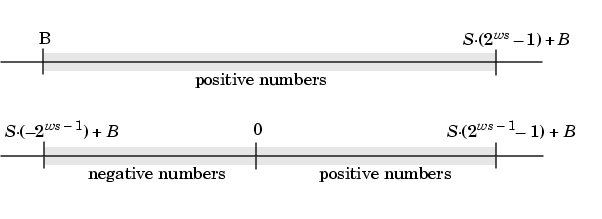

| Fixed-Point Blockset |   |
Range and Precision
The range of a number gives the limits of the representation while the precision gives the distance between successive numbers in the representation. The range and precision of a fixed-point number depends on the length of the word and the scaling.
Range
The range of representable numbers for an unsigned and two's complement fixed-point number of size ws, scaling S, and bias B is illustrated below.

For both the signed and unsigned fixed-point numbers of any data type, the number of different bit patterns is 2ws.
For example, if the fixed-point data type is an integer with scaling defined as S = 1 and B = 0, then the maximum unsigned value is 2ws - 1 since zero must be represented. In two's complement, negative numbers must be represented as well as zero so the maximum value is 2ws - 1- 1. Additionally, since there is only one representation for zero, there must be an unequal number of positive and negative numbers. This means there is a representation for -2ws - 1 but not for 2ws - 1.
Precision
The precision (scaling) of integer and fractional data types is specified by the default radix point. For generalized fixed-point data types, the scaling must be explicitly defined as either [Slope Bias] or radix point-only. In either case, the precision is given by the slope.
Fixed-Point Data Type Parameters
The low limit, high limit, and default radix point-only scaling for the supported fixed-point data types discussed in Radix Point Interpretation are given below. See Limitations on Precision and Limitations on Range for more information.
 | Quantization | Example: Fixed-Point Scaling |  |